VOLVO XC90 TWIN ENGINE 2019 Owners Manual
Manufacturer: VOLVO, Model Year: 2019, Model line: XC90 TWIN ENGINE, Model: VOLVO XC90 TWIN ENGINE 2019Pages: 697, PDF Size: 10.33 MB
Page 581 of 697
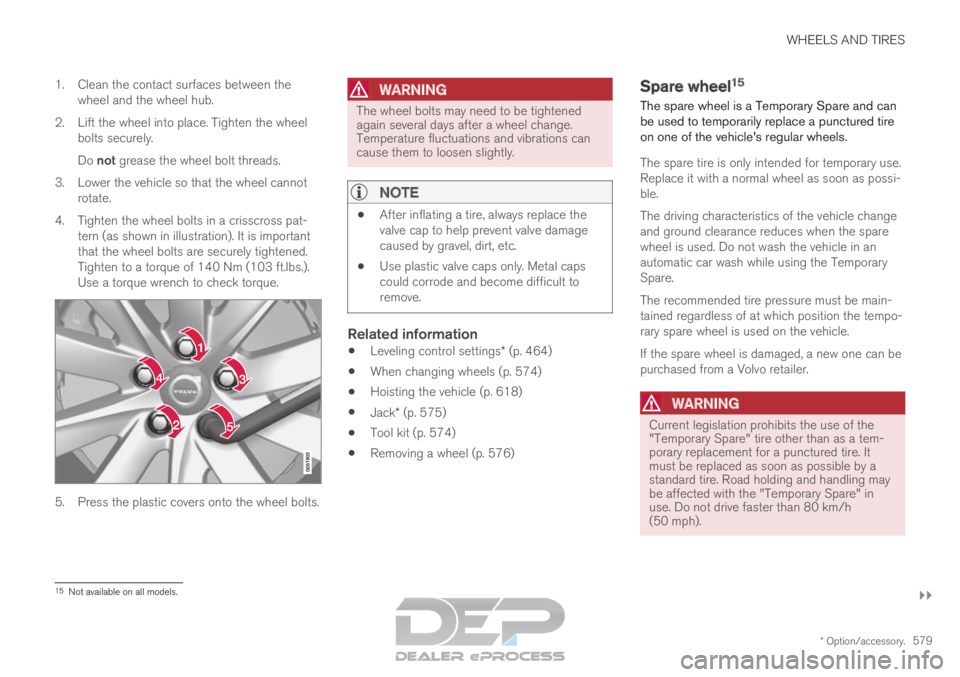
WHEELS AND TIRES
}}
* Option/accessory. 579
1.
Clean the contact surfaces between the
wheel and the wheel hub.
2. Lift the wheel into place. Tighten the wheel bolts securely.
Do not grease the wheel bolt threads.
3. Lower the vehicle so that the wheel cannot rotate.
4. Tighten the wheel bolts in a crisscross pat- tern (as shown in illustration). It is important
that the wheel bolts are securely tightened.
Tighten to a torque of 140 Nm (103 ft.lbs.).
Use a torque wrench to check torque. 5. Press the plastic covers onto the wheel bolts.
WARNING The wheel bolts may need to be tightened
again several days after a wheel change.
Temperature fluctuations and vibrations can
cause them to loosen slightly.
NOTE
After inflating a tire, always replace the
valve cap to help prevent valve damage
caused by gravel, dirt, etc.
Use plastic valve caps only. Metal caps
could corrode and become difficult to
remove.
Related information
Leveling control settings* (p. 464)
When changing wheels (p. 574)
Hoisting the vehicle (p. 618)
Jack* (p. 575)
Tool kit (p. 574)
Removing a wheel (p. 576) Spare wheel
15
The spare wheel is a Temporary Spare and can
be used to temporarily replace a punctured tire
on one of the vehicle's regular wheels.
The spare tire is only intended for temporary use.
Replace it with a normal wheel as soon as possi-
ble.
The driving characteristics of the vehicle change
and ground clearance reduces when the spare
wheel is used. Do not wash the vehicle in an
automatic car wash while using the Temporary
Spare.
The recommended tire pressure must be main-
tained regardless of at which position the tempo-
rary spare wheel is used on the vehicle.
If the spare wheel is damaged, a new one can be
purchased from a Volvo retailer.
WARNING Current legislation prohibits the use of the
"Temporary Spare" tire other than as a tem-
porary replacement for a punctured tire. It
must be replaced as soon as possible by a
standard tire. Road holding and handling may
be affected with the "Temporary Spare" in
use. Do not drive faster than 80 km/h
(50 mph).
15
Not available on all models.
Page 582 of 697
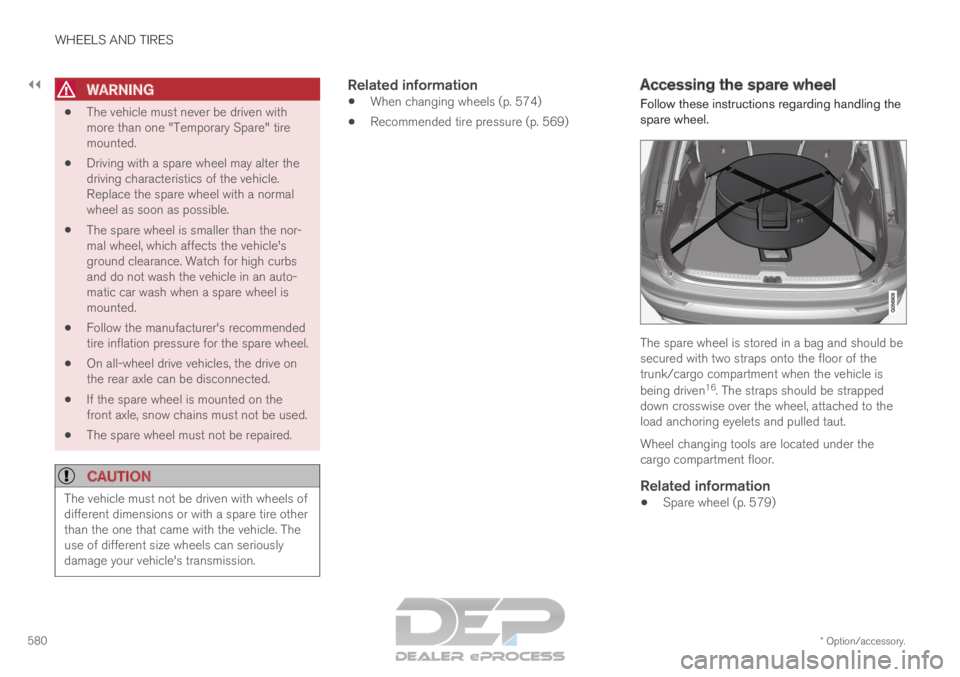
||WHEELS AND TIRES
* Option/accessory.
580
WARNING
The vehicle must never be driven with
more than one "Temporary Spare" tire
mounted.
Driving with a spare wheel may alter the
driving characteristics of the vehicle.
Replace the spare wheel with a normal
wheel as soon as possible.
The spare wheel is smaller than the nor-
mal wheel, which affects the vehicle's
ground clearance. Watch for high curbs
and do not wash the vehicle in an auto-
matic car wash when a spare wheel is
mounted.
Follow the manufacturer's recommended
tire inflation pressure for the spare wheel.
On all-wheel drive vehicles, the drive on
the rear axle can be disconnected.
If the spare wheel is mounted on the
front axle, snow chains must not be used.
The spare wheel must not be repaired.
CAUTION The vehicle must not be driven with wheels of
different dimensions or with a spare tire other
than the one that came with the vehicle. The
use of different size wheels can seriously
damage your vehicle's transmission.
Related information
When changing wheels (p. 574)
Recommended tire pressure (p. 569) Accessing the spare wheel
Follow these instructions regarding handling the
spare wheel. The spare wheel is stored in a bag and should be
secured with two straps onto the floor of the
trunk/cargo compartment when the vehicle is
being driven
16
. The straps should be strapped
down crosswise over the wheel, attached to the
load anchoring eyelets and pulled taut.
Wheel changing tools are located under the
cargo compartment floor.
Related information
Spare wheel (p. 579)
Page 583 of 697
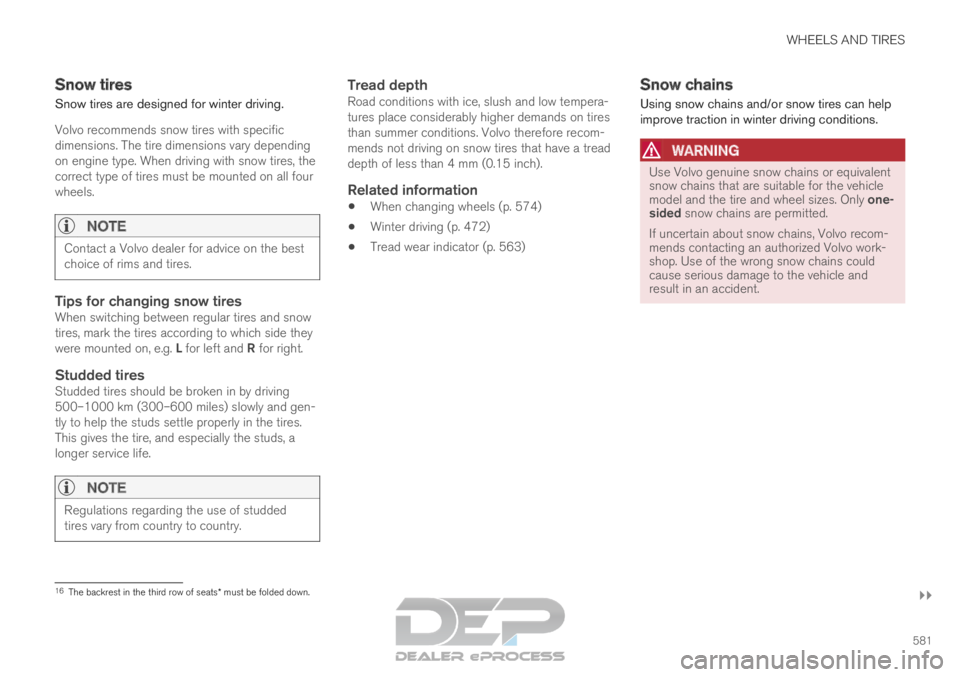
WHEELS AND TIRES
}}
581
Snow tires
Snow tires are designed for winter driving.
Volvo recommends snow tires with specific
dimensions. The tire dimensions vary depending
on engine type. When driving with snow tires, the
correct type of tires must be mounted on all four
wheels.
NOTE Contact a Volvo dealer for advice on the best
choice of rims and tires.
Tips for changing snow tiresWhen switching between regular tires and snow
tires, mark the tires according to which side they
were mounted on, e.g. L for left and R for right.
Studded tiresStudded tires should be broken in by driving
500–1000 km (300–600 miles) slowly and gen-
tly to help the studs settle properly in the tires.
This gives the tire, and especially the studs, a
longer service life.
NOTE
Regulations regarding the use of studded
tires vary from country to country.
Tread depthRoad conditions with ice, slush and low tempera-
tures place considerably higher demands on tires
than summer conditions. Volvo therefore recom-
mends not driving on snow tires that have a tread
depth of less than 4 mm (0.15 inch).
Related information
When changing wheels (p. 574)
Winter driving (p. 472)
Tread wear indicator (p. 563) Snow chains
Using snow chains and/or snow tires can help
improve traction in winter driving conditions.
WARNING Use Volvo genuine snow chains or equivalent
snow chains that are suitable for the vehicle
model and the tire and wheel sizes. Only one-
sided snow chains are permitted.
If uncertain about snow chains, Volvo recom-
mends contacting an authorized Volvo work-
shop. Use of the wrong snow chains could
cause serious damage to the vehicle and
result in an accident.
16
The backrest in the third row of seats* must be folded down.
Page 584 of 697
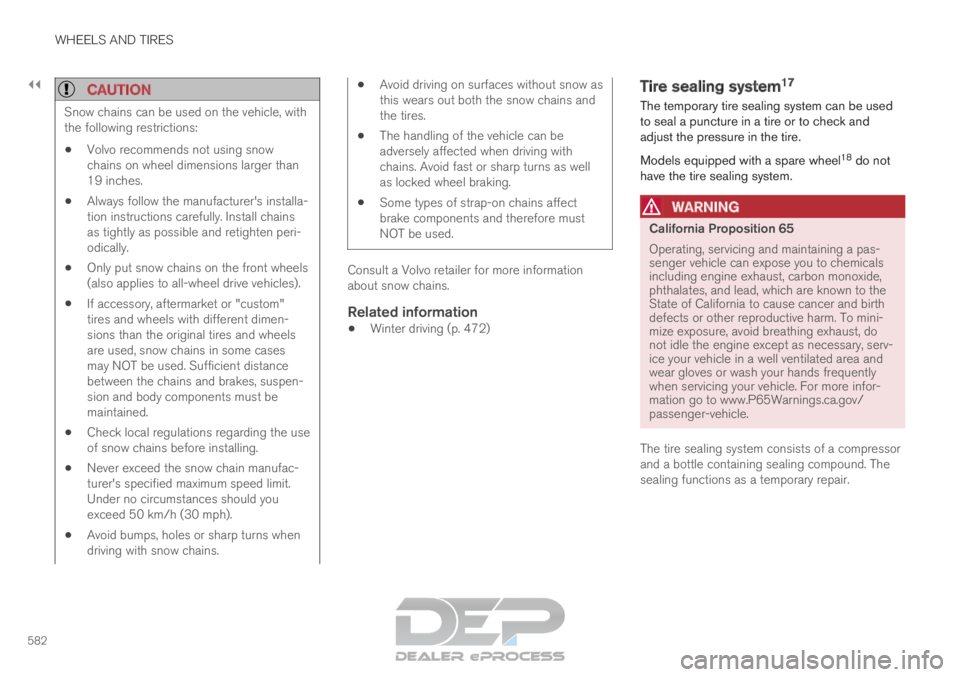
||WHEELS AND TIRES
582
CAUTION
Snow chains can be used on the vehicle, with
the following restrictions:
Volvo recommends not using snow
chains on wheel dimensions larger than
19 inches.
Always follow the manufacturer's installa-
tion instructions carefully. Install chains
as tightly as possible and retighten peri-
odically.
Only put snow chains on the front wheels
(also applies to all-wheel drive vehicles).
If accessory, aftermarket or "custom"
tires and wheels with different dimen-
sions than the original tires and wheels
are used, snow chains in some cases
may NOT be used. Sufficient distance
between the chains and brakes, suspen-
sion and body components must be
maintained.
Check local regulations regarding the use
of snow chains before installing.
Never exceed the snow chain manufac-
turer's specified maximum speed limit.
Under no circumstances should you
exceed 50 km/h (30 mph).
Avoid bumps, holes or sharp turns when
driving with snow chains.
Avoid driving on surfaces without snow as
this wears out both the snow chains and
the tires.
The handling of the vehicle can be
adversely affected when driving with
chains. Avoid fast or sharp turns as well
as locked wheel braking.
Some types of strap-on chains affect
brake components and therefore must
NOT be used. Consult a Volvo retailer for more information
about snow chains.
Related information
Winter driving (p. 472) Tire sealing system
17
The temporary tire sealing system can be used
to seal a puncture in a tire or to check and
adjust the pressure in the tire.
Models equipped with a spare wheel 18
do not
have the tire sealing system.
WARNING California Proposition 65
Operating, servicing and maintaining a pas-
senger vehicle can expose you to chemicals
including engine exhaust, carbon monoxide,
phthalates, and lead, which are known to the
State of California to cause cancer and birth
defects or other reproductive harm. To mini-
mize exposure, avoid breathing exhaust, do
not idle the engine except as necessary, serv-
ice your vehicle in a well ventilated area and
wear gloves or wash your hands frequently
when servicing your vehicle. For more infor-
mation go to www.P65Warnings.ca.gov/
passenger-vehicle.
The tire sealing system consists of a compressor
and a bottle containing sealing compound. The
sealing functions as a temporary repair.
Page 585 of 697

WHEELS AND TIRES
}}
583
NOTE The sealing compound effectively seals tires
with punctures in the tread but may not be
able to fully seal tires with punctures in the
sidewall. Do not use the tire sealing system
on tires with large tears, cracks or similar
damage.
NOTE
The compressor is intended for temporary tire
sealing and is approved by Volvo.
LocationThe tire sealing system is located in a foam block
under the floor of the cargo compartment.
Sealing compound expiration dateThe sealing compound bottle must be replaced if
its expiration date has passed (see the decal on
the bottle). Handle the old bottle as hazardous
waste.
Related information
Using the tire sealing system (p. 583)
Inflate tires with the compressor included in
the tire sealing system (p. 587)
Tires (p. 560) Using the tire sealing system
Sealing a tire using the tire sealing system, the
Temporary Mobility Kit (TMK).
Overview Electrical cable
Hose
Air release valve
Protective hose cover
Speed limit sticker
Bottle holder (orange cover)
Air pressure gauge
17
Certain models only.
18 Not available on all models.
Page 586 of 697

||WHEELS AND TIRES
584 Sealing compound bottle
Switch
Connecting
NOTE
Do not break the seal of the bottle before
use. The seal is broken automatically when
the bottle is screwed into place.
WARNING Please keep the following points in mind
when using the tire sealing system:
The sealing compound bottle (no. 8 in the
illustration) contains 1) rubber latex, natu-
ral and 2) ethanediol. These substances
are harmful if swallowed.
The contents of this bottle may cause
allergic skin reactions or otherwise be
potentially harmful to the respiratory tract,
the skin, the central nervous system, and
the eyes.
Precautions:
Keep out of reach of children.
Do not ingest the contents.
Avoid prolonged or repeated contact with
the skin. Remove any clothing that has
come into contact with sealant.
Wash thoroughly after handling.
First aid:
Skin: Wash affected areas of the skin
with soap and water. Get medical atten-
tion if symptoms occur.
Eyes: Flush with plenty of water for least
15 minutes, occasionally lifting the upper
and lower eyelids. Get medical attention if
symptoms occur.
Inhalation: Move the exposed person to
fresh air. If irritation persists, get medical
attention.
Ingestion: Do NOT induce vomiting
unless directed to do so by medical per-
sonnel. Get medical attention.
Disposal: Dispose of this material and its
container at a hazardous or special waste
collection point.
WARNING
Do not remove the bottle while the tire
sealing system is being used.
Do not remove the hose while the tire
sealing system is being used.
1.
Turn on the vehicle's hazard warning flashers
if the tire sealing system is to be used in an
area with traffic.
If the puncture was caused by a nail or simi-
lar object, do not remove it. It will help seal
the hole.
2. Peel off the speed limit sticker from the side of the compressor. Affix the decal to a clearly
visible location on the windshield to remind
the driver not to exceed this speed limit. Do
not drive faster than 80 km/h (50 mph) while
using a tire that has been temporarily
repaired with the tire sealing system.
Page 587 of 697
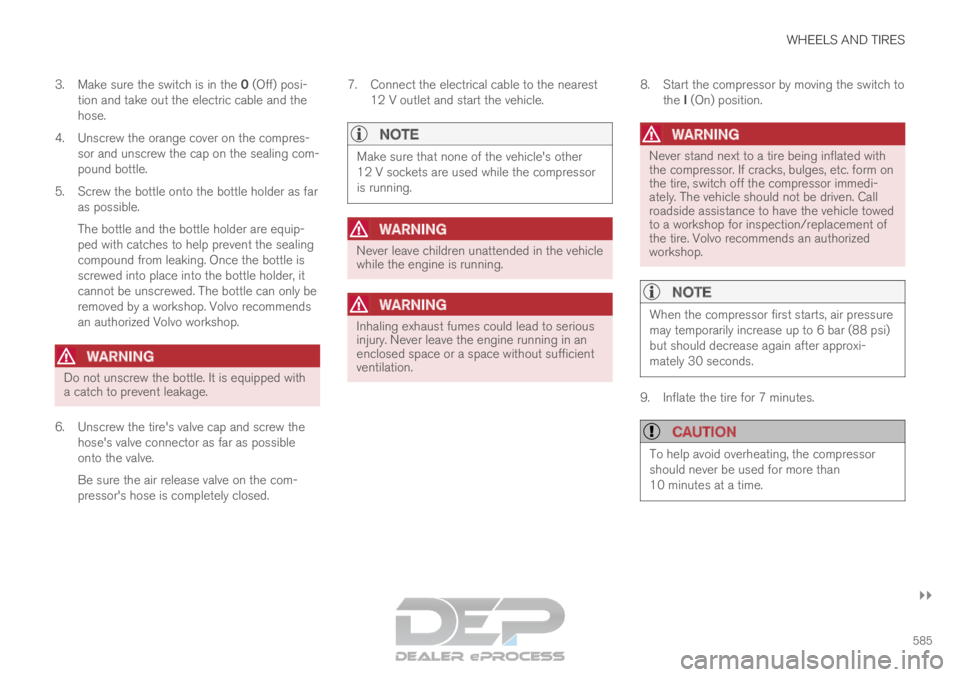
WHEELS AND TIRES
}}
585
3.
Make sure the switch is in the 0 (Off) posi-
tion and take out the electric cable and the
hose.
4.
Unscrew the orange cover on the compres-
sor and unscrew the cap on the sealing com-
pound bottle.
5. Screw the bottle onto the bottle holder as far as possible.
The bottle and the bottle holder are equip-
ped with catches to help prevent the sealing
compound from leaking. Once the bottle is
screwed into place into the bottle holder, it
cannot be unscrewed. The bottle can only be
removed by a workshop. Volvo recommends
an authorized Volvo workshop.
WARNING Do not unscrew the bottle. It is equipped with
a catch to prevent leakage.
6.
Unscrew the tire's valve cap and screw the
hose's valve connector as far as possible
onto the valve.
Be sure the air release valve on the com-
pressor's hose is completely closed. 7. Connect the electrical cable to the nearest
12 V outlet and start the vehicle.
NOTE Make sure that none of the vehicle's other
12 V sockets are used while the compressor
is running.
WARNING
Never leave children unattended in the vehicle
while the engine is running.
WARNING
Inhaling exhaust fumes could lead to serious
injury. Never leave the engine running in an
enclosed space or a space without sufficient
ventilation.
8.
Start the compressor by moving the switch to
the I (On) position.
WARNING Never stand next to a tire being inflated with
the compressor. If cracks, bulges, etc. form on
the tire, switch off the compressor immedi-
ately. The vehicle should not be driven. Call
roadside assistance to have the vehicle towed
to a workshop for inspection/replacement of
the tire. Volvo recommends an authorized
workshop.
NOTE
When the compressor first starts, air pressure
may temporarily increase up to 6 bar (88 psi)
but should decrease again after approxi-
mately 30 seconds.
9. Inflate the tire for 7 minutes.
CAUTION
To help avoid overheating, the compressor
should never be used for more than
10 minutes at a time.
Page 588 of 697

||WHEELS AND TIRES
586
10. Switch off the compressor and check the
inflation pressure using the air pressure
gauge. The inflation pressure should be
between 1.8 bar (22 psi) and 3.5 bar
(51 psi). If the inflation pressure is too high,
use the air release valve to release air.
WARNING If pressure falls below 1.8 bar (22 psi), the
hole in the tire may be too large. The vehicle
should not be driven. Call roadside assistance
to have the vehicle towed to a workshop for
inspection/replacement of the tire. Volvo rec-
ommends an authorized workshop.
11.
Switch off the compressor and remove the
electrical cable.
12. Unscrew the hose from the tire's valve and screw the valve cap back on.
NOTE
After inflating a tire, always replace the
valve cap to help prevent valve damage
caused by gravel, dirt, etc.
Use plastic valve caps only. Metal caps
could corrode and become difficult to
remove. 13. Put the protective hose cover onto the hose
to help prevent leakage of any residual seal-
ing compound. Return the equipment to the
cargo compartment.
14.
Immediately drive the vehicle at least 3 km
(2 miles) at a maximum speed of 80 km/h
(50 mph) to allow the sealing compound to
seal the tire, and then recheck the inflation
pressure.
NOTE During the tire's first revolution, some sealing
compound may spray out of the puncture
hole.
WARNING
Before driving away, make sure that no one is
near the vehicle who could be sprayed with
sealing compound. Make sure no one is
within 2 meters(7 feet) of the vehicle.
15. Rechecking the inflation pressure
Connect the hose to the tire's valve and
screw the hose connector onto the valve as
far as possible. The compressor must be
switched off. 16.
Check the inflation pressure on the air pres-
sure gauge.
If the pressure is under 1.3 bar (19 psi),
the tire is not sufficiently sealed. The vehi-
cle should not be driven. Call roadside
assistance to have the vehicle towed.
If the inflation pressure is higher than
1.3 bar (19 psi), the tire must be inflated
to the inflation pressure specified on the
tire pressure decal on the driver's side
door pillar (1 bar = 100 kPa = 14.5 psi). If
the inflation pressure is too high, use the
air release valve to release air.
NOTE Replace the sealing compound bottle and
hose after use. Volvo recommends having
these replaced by an authorized Volvo work-
shop.
WARNING
Check inflation pressure regularly.
Volvo recommends driving to the nearest author-
ized Volvo workshop to have the tire replaced/
repaired. Inform the workshop that the tire con-
tains sealing compound.
Page 589 of 697
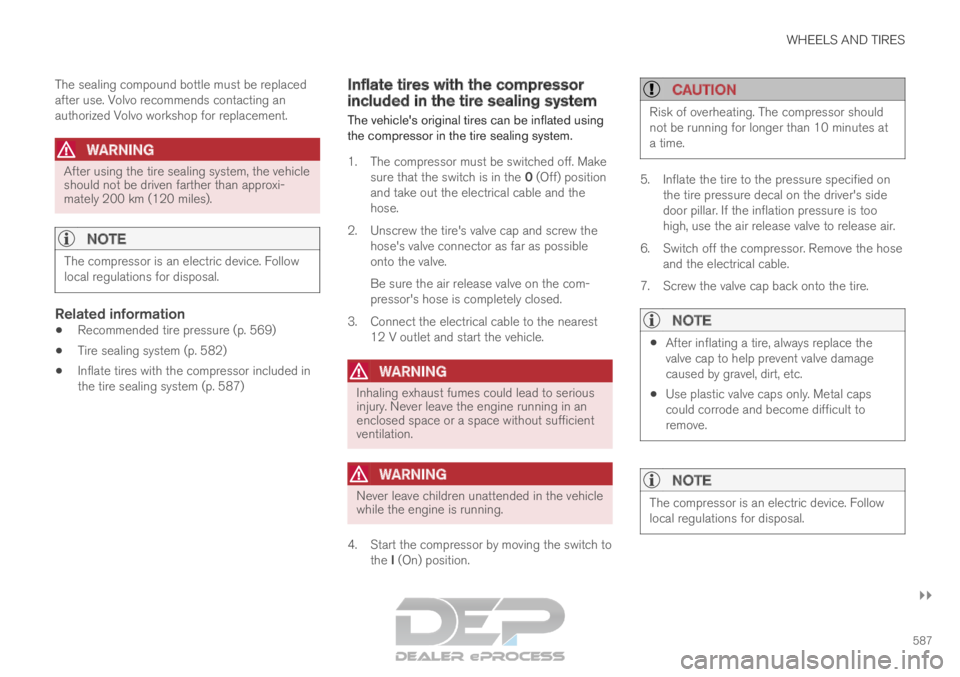
WHEELS AND TIRES
}}
587
The sealing compound bottle must be replaced
after use. Volvo recommends contacting an
authorized Volvo workshop for replacement.
WARNING
After using the tire sealing system, the vehicle
should not be driven farther than approxi-
mately 200 km (120 miles).
NOTE
The compressor is an electric device. Follow
local regulations for disposal.
Related information
Recommended tire pressure (p. 569)
Tire sealing system (p. 582)
Inflate tires with the compressor included in
the tire sealing system (p. 587) Inflate tires with the compressor
included in the tire sealing system
The vehicle's original tires can be inflated using
the compressor in the tire sealing system.
1. The compressor must be switched off. Make
sure that the switch is in the 0 (Off) position
and take out the electrical cable and the
hose.
2.
Unscrew the tire's valve cap and screw the
hose's valve connector as far as possible
onto the valve.
Be sure the air release valve on the com-
pressor's hose is completely closed.
3. Connect the electrical cable to the nearest 12 V outlet and start the vehicle.
WARNING Inhaling exhaust fumes could lead to serious
injury. Never leave the engine running in an
enclosed space or a space without sufficient
ventilation.
WARNING
Never leave children unattended in the vehicle
while the engine is running.
4.
Start the compressor by moving the switch to
the I (On) position.
CAUTION Risk of overheating. The compressor should
not be running for longer than 10 minutes at
a time.
5. Inflate the tire to the pressure specified on
the tire pressure decal on the driver's side
door pillar. If the inflation pressure is too
high, use the air release valve to release air.
6.
Switch off the compressor. Remove the hose
and the electrical cable.
7. Screw the valve cap back onto the tire.
NOTE
After inflating a tire, always replace the
valve cap to help prevent valve damage
caused by gravel, dirt, etc.
Use plastic valve caps only. Metal caps
could corrode and become difficult to
remove.
NOTE The compressor is an electric device. Follow
local regulations for disposal.
Page 590 of 697
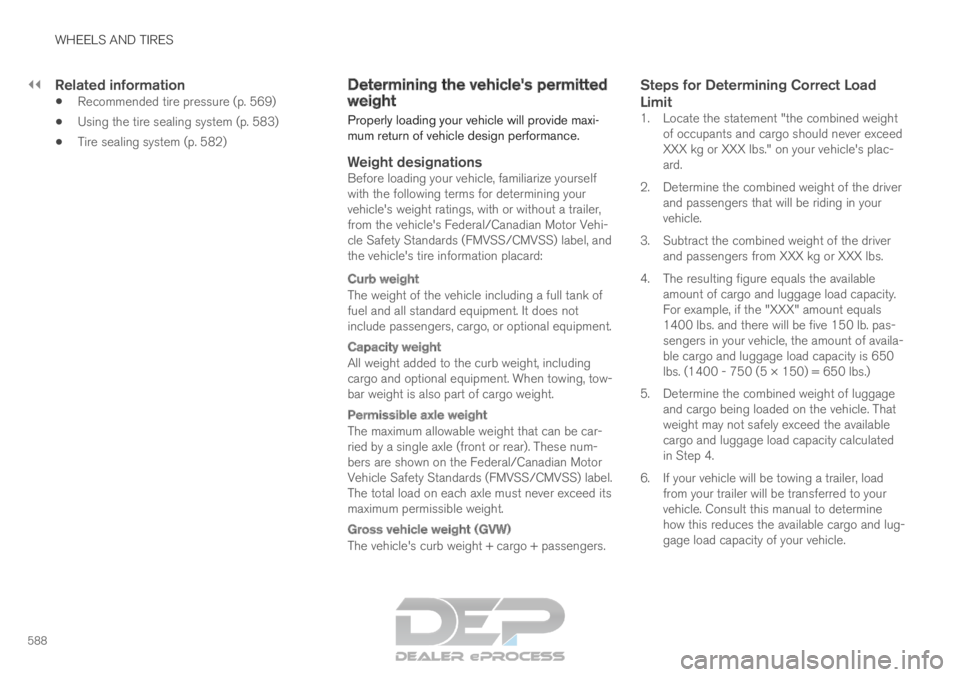
||WHEELS AND TIRES
588
Related information
Recommended tire pressure (p. 569)
Using the tire sealing system (p. 583)
Tire sealing system (p. 582) Determining the vehicle's permitted
weight
Properly loading your vehicle will provide maxi-
mum return of vehicle design performance.
Weight designationsBefore loading your vehicle, familiarize yourself
with the following terms for determining your
vehicle's weight ratings, with or without a trailer,
from the vehicle's Federal/Canadian Motor Vehi-
cle Safety Standards (FMVSS/CMVSS) label, and
the vehicle's tire information placard:
Curb weight
The weight of the vehicle including a full tank of
fuel and all standard equipment. It does not
include passengers, cargo, or optional equipment.
Capacity weight
All weight added to the curb weight, including
cargo and optional equipment. When towing, tow-
bar weight is also part of cargo weight.
Permissible axle weight
The maximum allowable weight that can be car-
ried by a single axle (front or rear). These num-
bers are shown on the Federal/Canadian Motor
Vehicle Safety Standards (FMVSS/CMVSS) label.
The total load on each axle must never exceed its
maximum permissible weight.
Gross vehicle weight (GVW)
The vehicle's curb weight + cargo + passengers.
Steps for Determining Correct Load
Limit
1. Locate the statement "the combined weight of occupants and cargo should never exceed
XXX kg or XXX lbs." on your vehicle's plac-
ard.
2. Determine the combined weight of the driver and passengers that will be riding in your
vehicle.
3. Subtract the combined weight of the driver and passengers from XXX kg or XXX lbs.
4. The resulting figure equals the available amount of cargo and luggage load capacity.
For example, if the "XXX" amount equals
1400 lbs. and there will be five 150 lb. pas-
sengers in your vehicle, the amount of availa-
ble cargo and luggage load capacity is 650
lbs. (1400 - 750 (5 × 150) = 650 lbs.)
5. Determine the combined weight of luggage and cargo being loaded on the vehicle. That
weight may not safely exceed the available
cargo and luggage load capacity calculated
in Step 4.
6. If your vehicle will be towing a trailer, load from your trailer will be transferred to your
vehicle. Consult this manual to determine
how this reduces the available cargo and lug-
gage load capacity of your vehicle.